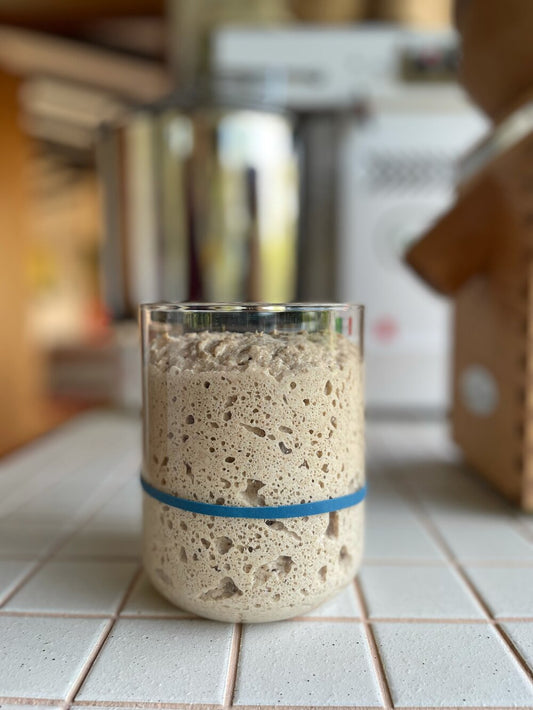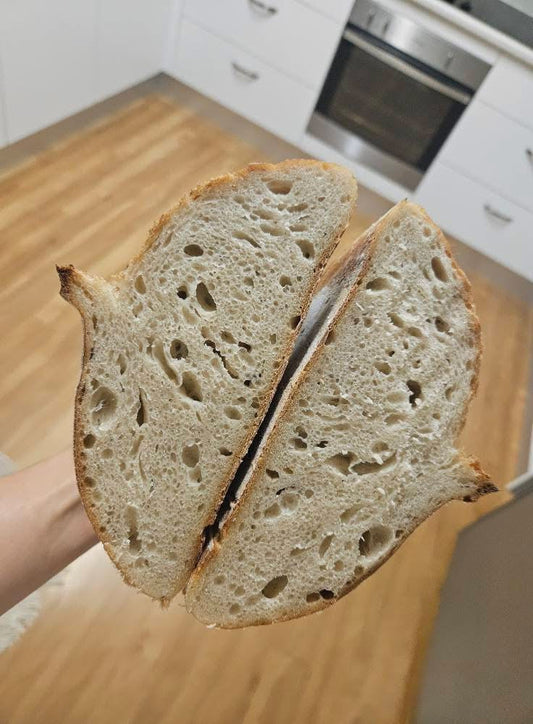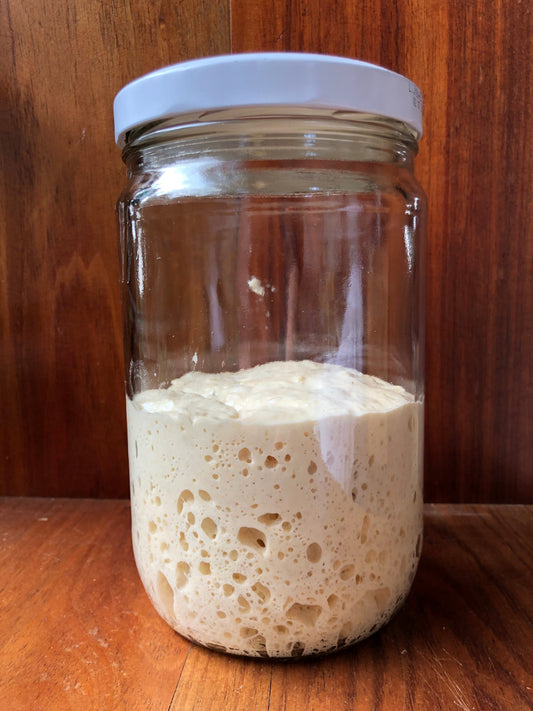COUNTRY SOURDOUGH BREAD RECIPE

What is Country Sourdough—and Why You Should Make the Effort
Country sourdough is a traditional style of sourdough bread made with a blend of white and whole-wheat (or sometimes rye) flours. It typically uses a long fermentation process with a natural starter, giving it a complex flavour, chewy crust, and open, airy crumb. The “country” in its name refers to its rustic, farmhouse-style origins—baked with simple, honest ingredients and time-honoured techniques.
For everything you need—starter, tools, and flour—get our Complete Sourdough Starter Kit - perfect for beginners or anyone ready to bake real, wholesome sourdough at home.
IMPORTANT BAKER’S NOTES:
Sizes
Two loaf sizes available below, choose one that best suits your banneton size. Recipes can be doubled or tripled to make multiple loaves.
Baker’s Percentages (Learn more & what is it?)
Recipes are based on baker’s percentages - flour 100% (made up of 80% white bread flour, 20% wholegrain flour), water 75%, starter 20%, salt 2%.
Addition of Wholegrain Flour
Using the same method as the Basic White Sourdough Recipe, the Country Sourdough Bread has the addition of wholegrain wheat flour to give bread more flavour & nutrition. As you familiarise yourself with the process & learn to better read your dough, you can start making changes to the baker’s percentages of wholegrain flour & water to suit your preferred outcomes.
Room Temperature
It’s important to note that this recipe specifies room temperature to be around 24 degrees Celsius. As temperature can directly affect fermentation - warmer dough will ferment faster than colder dough, so rest times in this recipe is only a guide & can vary depending on your own kitchen’s temperature. Learning to read your dough is more important than following set times in a recipe, a skill that is learnt through doing & baking over time.
Active Starter
You must have an active starter before commencing this recipe. Please go back to Part 1 of the Bread Kit Guide if you haven't completed this.
If you need a sourdough starter, please see our Organic Starter Flakes, which can be activated within 24 hours via instructions here.
RECIPE & INSTRUCTIONS
Allow about 24 hours for this recipe. This recipe is intended for beginner bakers. For intermediate bakers, you could try increasing the wholegrain flour to 30-50% & experiment with different whole grain flours (spelt or rye), please adjust the hydration percentage to suit.
INGREDIENTS
Starter Build - allows enough leftover to keep starter alive
50g starter
50g flour mix of 50/50 white & wholewheat
50g water (lukewarm)
Continuous Fermentation: When using your active starter for baking, always leave some behind (a tablespoon is sufficient) to keep the starter alive. For more information on maintaining a healthy starter, please visit the Starter Maintenance.
Makes 1 loaf (750g dough) - small sized proving bannetons
80g active starter (from starter build above)
320g white baker’s flour
80g wholegrain wheat flour (you could also try whole rye or spelt)
275g water (lukewarm)
8g salt (preferably fine salt)
Makes 1 loaf (950g dough) - medium sized proving bannetons
100g active starter (from starter build above)
400g white baker’s flour
100g wholegrain wheat flour (you could also try whole rye or spelt)
345g water (lukewarm)
10g salt (preferably fine salt)
METHOD
Recommended: Watch the demonstration video & read through the instructions below to familiarise yourself with the process before starting.
1. PREPARING THE STARTER BUILD
Every time you bake a loaf of sourdough, it is recommended you do a starter build. It ensures that your starter is as strong as it can be. This means roughly 3-4 hours before you plan to mix the dough (at 24-26°C room temperature), combine the starter, flour & water for the starter build & mix well to combine. Once it roughly doubles in size & showing bubbles, it is ready to use. Depending on which size loaf you choose to bake you will use 80g or 100g of this for the dough; retain the rest for maintaining your starter.
What is a starter build & do I need to do one?
This all depends on when your starter was last fed! Making good bread requires a starter that has been fed every 12 hours & is doubling in size. So often a starter build is required to refresh an unfed starter (unfed for more than 24 hours) to ensure it is at its optimal peak when adding into a bread mix.
2. BUILD THE DOUGH
At least 30 minutes before you plan to mix the dough, place the water in a mixing bowl & then add the flour. Using the a bowl scraper or Danish dough whisk, mix all the flour & water together into a shaggy dough. If you're finding your dough is very sticky, don't stress, a 30 minutes rest will help bring the dough together, this is often referred to as the “autolyse” stage. Cover with a damp tea towel & set aside in a warm place.
After 30 minutes (autolyse), add your active starter & salt. Now roll your sleeves up and have a bowl of water handy. Before mixing with your hands, wet them in the bowl & begin to mix by rotating the bowl with one hand & using your other hand to massage & fold the edges into the centre. Do this for 5 minutes or until the starter & salt is fully incorporated into the dough. At this point your dough will still look a little shaggy (that’s ok!) just make sure there are no dry lumps.
Cover with a damp cloth & rest at room temperature (24 -26 degrees celsius is preferred) for around 30-45 minutes. If your room temperature is a cooler (below 21), than leave to rest for 1 hour or when you're dough looks relaxed.
3. STRETCH & FOLD ( THEN COIL FOLDS)
Folding, rather than kneading, is the preferred method for this flour and hydration combination, and it will give you better results. Stretching and folding helps strengthen and tighten the dough, making it easier to handle and less sticky. It also helps to build dough structure, improve oven spring & helps achieve an open crumb.
Firstly, do one session of stretch & folds. Wet your hands. Use one hand to hold & turn the bowl, while the other hand to fold - folding the edges of the dough up & into itself, rotating the bowl as you go. Do this 5-6 times until the dough feels tight without breaking the skin of the dough. Then turn the dough over so the smooth side is facing up (you may want to watch the video). Cover with a wet tea towel or lid & rest for 30-45 minutes to allow the gluten to relax & fermentation to occur.
After the first stretch & fold session, we will switch to a coil fold technique, which focuses on folding the dough instead of stretching it. This is a gentler method & one that helps to trap tiny air bubbles created during fermentation & helps give your bread an airy crumb. Please watch the above video for a demonstration of this technique.
To do a coil fold – wet both hands, then tuck your fingers under the dough to lift it out of the bowl, then placing it gently back down but making sure the stretched side is folded under the dough. Now turn the bowl 180 degrees and do the same again. Finally lift the dough one last time to fold the two open ends under. Keep the dough smooth side up and cover with a wet towel to let it rest for 45 minutes or until your dough has relaxed. Repeat this coil fold 2 more times.
Dough tips:
- A stiff dough will require less sets of folds at longer intervals. If you can no longer stretch & fold your dough, than do not force it.
- Wetter doughs will require more sets of folds at shorter intervals.
- It’s important to read your dough & observe how quickly/slowly it relaxes. Usually there is enough strength in the dough if the dough stays together after about 30 mins.
4. BULK PROVING
After doing your final set of coil folds, cover your bowl with a damp cloth & let the dough rest & ferment, this typically takes 3-4 hours sometimes longer depending on your dough & room temperature. The aim of the "bulk proving" is to build up the gluten structure & gives the yeast a chance to leaven the dough.
At this point, the dough will rise & feel stronger & show signs of fermentation (bubbles & sweet fermented smell). Bulk times above are a guide only & beginners should read the dough. Typically the dough should almost double in size before proceeding to the next step - shaping.
Learning to read these signs & knowing when it is ready to shape can take time to understand, every bake is never the same, so it takes persistence & experience (through baking) to fully understand the process. Be kind to yourself, learn from your mistakes & enjoy the process!
5. PRE SHAPE & FINAL SHAPING
After your dough has done its bulk proving, tip the dough onto a slightly moist bench (prevents dough from sticking). Using firm pressure to create tension - pull the dough towards you to create tension on the smooth side (best to watch the video at 40 seconds in if you’re unsure). You want to achieve a tight ball without breaking the smooth surface of the dough. Let it rest for 30 minutes before the final shaping.
Before doing the final shape, dust your bannetons with some flour to stop it from sticking. You can use just bread flour or rice/semolina flour, its really a personal preference.
When the dough has relaxed, flip your dough over (seam side up) & shape your dough as per the video above (oval shape).
To shape for a round banneton, flip your dough over (seam side up) & pull the sides into the centre until you create a tight ball & turn it over smooth side facing up. Then pull the dough ball towards, turning it you to create more tension without breaking the smooth surface. Place the dough ball inside your round banneton with seam side facing up. See our round shaping video here.
Lastly, dust the tops with a little flour before covering with a plastic bag. You may like to bake it the same day, just let it rest at room temperature for a few hours before baking. For amazing flavour, we recommend putting the whole banneton into the fridge covered overnight.
Why do an overnight cold prove?
Though optional, a long slow fermentation at this final stage leads to better flavour development in your bread. It also allows your bread to take on the shape of the banneton better, giving it improved shape & outer surface for scoring.
6. BAKE YOUR BREAD (DUTCH OVEN METHOD)
This is the preferred method for baking bread at home. If you don't have a Dutch oven, you can buy one here.
Preheat your oven to the maximum temperature (230 degrees Celsius or more) and place your dutch oven inside. Heat for 45 minutes.
Place a piece of baking paper (slightly longer & wider than your loaf) onto your bench. Take your dough out of the fridge (if applicable) & sprinkle some semolina on top (optional), then tip the loaf out of the proving banneton onto the paper, seam side down. Bread can be baked straight from the fridge. See video to see how it’s done.
Use your baker's lame/blade to score the top of the loaf with a 2-3mm cut. This allows the loaf to expand & rise with the help of the steam & hot pan. Carefully transfer the loaf into the hot Dutch oven, put 2 cubes of ice, then pop the lid back on & into the oven. Bake for 20 minutes with the lid on.
After 20 minutes, carefully take the lid off the dutch oven and bake for a further 10-15 minutes or until golden brown. Let it cool on a baking rack for 15 minutes before cutting.
Enjoy!
Need help?
Our support team is always happy to assist with your sourdough questions!
Chat with us via the website chat (bottom right corner) Monday to Friday, 9am–5pm, and one of our team members will be glad to help you on your bread journey.
For community help, join our friendly Facebook Support Group.
Happy baking!




